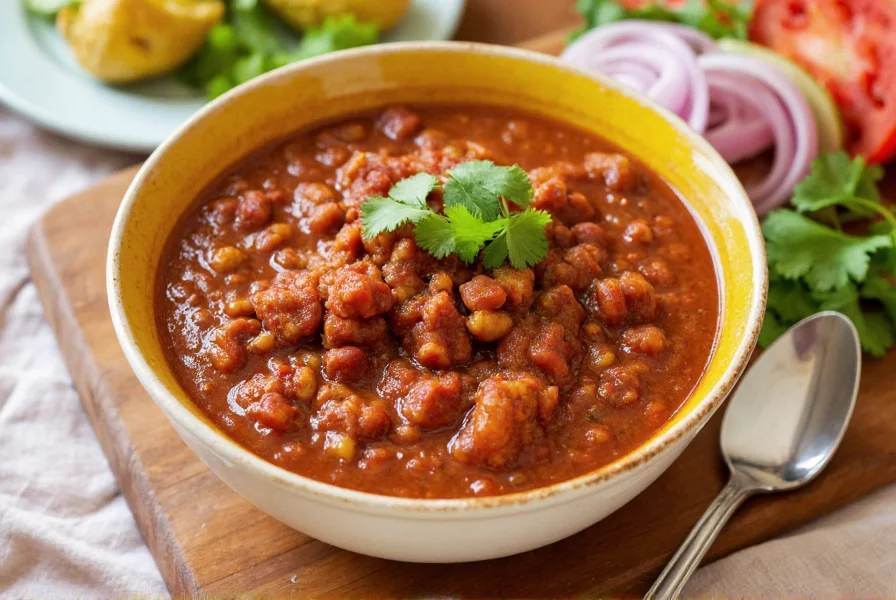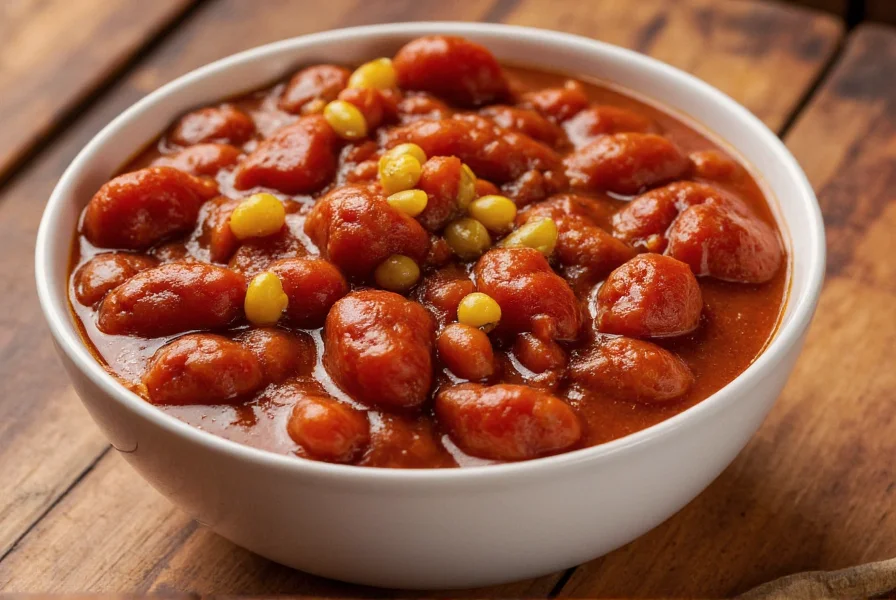Creating delicious chili that fits within a diabetes meal plan doesn't mean sacrificing flavor or satisfaction. The right diabetic chili balances protein, healthy fats, and complex carbohydrates to prevent blood sugar spikes while delivering the hearty, comforting meal you crave. Understanding which ingredients to emphasize and which to modify transforms traditional chili into a blood sugar-friendly dish that satisfies both your palate and health goals.
Why Chili Works Well for Diabetes Management
Chili naturally aligns with diabetes nutrition principles when properly formulated. The combination of lean proteins, high-fiber beans, and non-starchy vegetables creates a meal with a favorable glycemic profile. Research shows that high-fiber meals like properly constructed chili can improve insulin sensitivity and help maintain stable blood glucose levels throughout the day.
The magic happens through three key mechanisms: protein slows carbohydrate absorption, fiber adds bulk without calories, and healthy fats promote satiety. This trifecta prevents the rapid blood sugar spikes that concern people managing diabetes, making diabetic-friendly chili an excellent choice for both type 1 and type 2 diabetes meal planning.
Essential Components of Blood Sugar-Friendly Chili
Transforming traditional chili into a diabetes-appropriate meal requires strategic ingredient selection and preparation techniques. Focus on these critical elements to create a truly diabetic-friendly chili recipe that delivers both nutrition and flavor.
Smart Protein Selection
Choose lean protein sources that minimize saturated fat while maximizing satiety. Ground turkey, extra-lean ground beef (95% lean), or plant-based proteins like extra beans provide excellent alternatives to traditional fatty meat options. For optimal blood sugar control, aim for 20-30g of protein per serving without excessive fat content.

Fiber-Rich Bean Blends
Beans form the nutritional backbone of diabetic-friendly chili. Combine different varieties like kidney beans, black beans, and pinto beans to maximize soluble fiber content. Soluble fiber specifically helps moderate blood sugar absorption. One cup of mixed beans provides approximately 15g of fiber - crucial for diabetes management. Always rinse canned beans thoroughly to remove excess sodium.
Vegetable Powerhouse Additions
Incorporate non-starchy vegetables to boost volume and nutrients without significantly increasing carbohydrate content. Bell peppers, zucchini, mushrooms, and tomatoes add flavor complexity while contributing valuable vitamins and minerals. These additions increase the meal's fiber content and create a more satisfying eating experience through volume eating principles.
| Diabetic Chili Ingredient | Carbohydrate Content (per 1/2 cup) | Fiber Content (per 1/2 cup) | Glycemic Load |
|---|---|---|---|
| Black beans (cooked) | 20g | 7.5g | 11 |
| Kidney beans (cooked) | 20g | 6.8g | 10 |
| Ground turkey (4oz) | 0g | 0g | 0 |
| Chopped bell peppers | 3g | 1.5g | 1 |
| Crushed tomatoes (no sugar added) | 5g | 1g | 2 |
Diabetic-Friendly Chili Recipe
This evidence-based diabetic chili recipe delivers robust flavor while maintaining strict blood sugar management parameters. Each serving contains approximately 38g total carbohydrates, 14g fiber, and 28g protein - creating an ideal nutritional profile for diabetes meal planning.
Ingredients
- 1 lb lean ground turkey (93% lean)
- 1 large onion, diced
- 3 cloves garlic, minced
- 1 bell pepper, diced
- 2 carrots, finely diced
- 1 zucchini, diced
- 1 (28oz) can no-sugar-added crushed tomatoes
- 1 (15oz) can black beans, rinsed
- 1 (15oz) can kidney beans, rinsed
- 1 (15oz) can cannellini beans, rinsed
- 2 tbsp chili powder
- 1 tbsp cumin
- 1 tsp smoked paprika
- 1 tsp oregano
- 1 cup low-sodium vegetable broth
- Salt and pepper to taste
Instructions
- Brown ground turkey in large pot over medium heat, breaking into small pieces
- Add onions, garlic, and bell pepper; sauté until softened (5-7 minutes)
- Stir in carrots and zucchini; cook 5 minutes more
- Add all spices and toast for 1 minute to release flavors
- Pour in crushed tomatoes, beans, and vegetable broth
- Simmer uncovered for 30-40 minutes, stirring occasionally
- Adjust seasoning and serve hot
Nutritional Analysis Per Serving (makes 6 servings)
| Nutrient | Amount | % Daily Value |
|---|---|---|
| Calories | 320 | - |
| Total Carbohydrates | 38g | 14% |
| Dietary Fiber | 14g | 50% |
| Sugars | 6g | - |
| Protein | 28g | 56% |
| Total Fat | 6g | 8% |
| Saturated Fat | 1.5g | 8% |
| Sodium | 320mg | 14% |
Maximizing Blood Sugar Benefits
To optimize your diabetic chili for blood glucose management, consider these evidence-based strategies:
- Portion Control: Stick to 1.5 cups per serving to maintain appropriate carbohydrate levels
- Timing Matters: Consume chili earlier in the day when insulin sensitivity is typically higher
- Pairing Strategy: Serve with a small side salad containing healthy fats like avocado to further slow glucose absorption
- Leftover Wisdom: Store portions in individual containers for consistent meal planning throughout the week
Research published in the Journal of the Academy of Nutrition and Dietetics confirms that consistent meal timing and composition significantly improves glycemic control in individuals with type 2 diabetes. Your diabetic-friendly chili becomes even more effective when incorporated into a structured eating pattern.
Customizing for Individual Diabetes Needs
Diabetes management requires personalization based on individual health status, medication regimen, and specific nutritional requirements. Consider these adjustments to tailor your diabetic chili recipe:
- For Type 1 Diabetes: Calculate precise carbohydrate counts to match insulin dosing
- For Kidney Complications: Reduce bean varieties and focus on lower-potassium options
- For Weight Management: Increase non-starchy vegetable content while maintaining protein levels
- For Enhanced Flavor: Add acid with lime juice or vinegar rather than sugar-based ingredients
Always consult with your healthcare provider or registered dietitian to determine the optimal nutritional approach for your specific diabetes management plan. The American Diabetes Association recommends personalized medical nutrition therapy as a critical component of comprehensive diabetes care.

Storage and Reheating Guidelines
Proper storage maintains both food safety and nutritional integrity of your diabetic-friendly chili. Follow these evidence-based storage recommendations:
- Cool chili completely before refrigerating (within 2 hours of cooking)
- Store in airtight containers for up to 4 days in the refrigerator
- Freeze individual portions for up to 3 months
- Reheat thoroughly to 165°F (74°C) before serving
- Avoid repeated reheating cycles which degrade nutritional quality
Studies show that properly stored chili maintains its fiber content and antioxidant properties for several days, making it an excellent option for diabetes meal prep. The soluble fiber in beans actually becomes more beneficial after refrigeration as it continues to develop resistant starch properties.
Frequently Asked Questions
Can people with diabetes eat beans in chili?
Yes, beans are excellent for diabetes management due to their high fiber and protein content which helps stabilize blood sugar. The American Diabetes Association specifically recommends including beans in diabetes meal plans. One serving (1/2 cup) of cooked beans typically contains 15g carbohydrates but also 7-8g of fiber, resulting in a much lower net carb count. Always rinse canned beans to reduce sodium content.
How many carbohydrates should a diabetic chili serving contain?
An ideal diabetic chili serving should contain 30-45g total carbohydrates with at least 10g of fiber. This creates a net carb range of 20-35g per serving, which fits within standard diabetes meal planning guidelines. The exact amount should be personalized based on individual carbohydrate goals established with a healthcare provider, but most adults with diabetes aim for 30-60g of carbohydrates per meal.
Is traditional chili bad for people with diabetes?
Traditional chili isn't inherently bad, but standard recipes often contain excessive carbohydrates from added sugars, high-fat meats, and insufficient fiber. By modifying ingredients to include more non-starchy vegetables, lean proteins, and multiple bean varieties while eliminating added sugars, traditional chili can be transformed into a diabetes-friendly meal that supports blood sugar management rather than hindering it.
Can diabetic chili help with weight management?
Yes, properly formulated diabetic chili supports weight management through high protein and fiber content that promotes satiety. The combination of lean protein and soluble fiber creates a feeling of fullness that reduces overall calorie intake. Research shows that high-fiber meals like bean-based chili can reduce subsequent food intake by up to 12%, making it an effective tool for both diabetes and weight management.
How does chili affect blood sugar levels?
Well-constructed diabetic chili has a minimal impact on blood sugar due to its balanced macronutrient profile. The protein slows carbohydrate absorption, while the high fiber content (particularly soluble fiber from beans) reduces the glycemic response. Studies show that meals combining protein, healthy fats, and fiber can reduce post-meal blood glucose spikes by 20-30% compared to high-carbohydrate meals. Monitoring your individual response with blood glucose testing is recommended.











 浙公网安备
33010002000092号
浙公网安备
33010002000092号 浙B2-20120091-4
浙B2-20120091-4